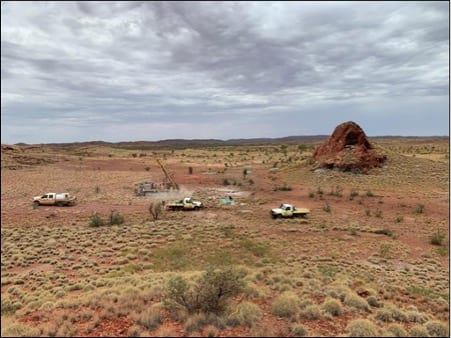Significant Copper And Lead Discovered In Maiden Pilbara Programme
Rumble Resources Limited (ASX: RTR) has discovered significant near-surface copper mineralisation with its maiden drilling activities on the Braeside project located in the Pilbara Region of Western Australia.
In the maiden drill programme at the Camel Hump Prospect, Rumble discovered wide zones (up to 40m wide) of near surface copper interpreted to be VMS mineralisation.
At the Barker Well Prospect Rumble has discovered three Pb breccia pipes with high grade Pb mineralisation.
Both prospects are open in all directions with assays pending.
Five target/prospects were tested by the current RC drilling programme at the Braeside Project. All prospects returned strong base metal mineralisation, however, at the Camel Hump and Barker Well Prospects very significant copper and lead mineralisation has been discovered.
The maiden RC drill programme of eight drill holes at the Camel Hump Prospect has been completed with very significant (visual) oxide copper mineralisation discovered in six shallow RC drill holes with assays pending. Notably, these are the first drill holes into the target region with no previous historic drilling.
Stringer style malachite, azurite, chalcocite and native copper observed over widths up to 40m(drill hole length intersection) are associated with intermediate volcaniclastics (siltstone) within andesite. At the base of the siltstone is manganiferous silic altered (sulphidic if fresh) black shale. Structural observations have indicated the copper mineralised volcaniclastic zone pre-dates foliation. Foliation and shearing are at a higher angle to the dip of copper mineralisation and lithology.
The style of mineralisation is considered volcanogenic and likely represents stringer copper sulphide zoning associated with VMS (volcanogenic hosted massive sulphide) type systems.
Meanwhile, at the Barker Well Prospect, Rumble has discovered three Pb breccia pipes defined over 750m which are completely open along strike and at depth by shallow RC Drilling.
The breccias pipes have formed at surface and are composed of massive galena with sphalerite within silica – chlorite – pyrite alteration zones with strong pervasive galena – pyrite – sphalerite haloes. The host rocks are andesitic basalts and volcaniclastics.
First assay results for nineteen (19) RC shallow drill holes included:
- 6m @ 7.58% Pb, 7.7 g/t Ag from 25m (BRRC141)
- 3m @ 6.07% Pb, 6.4 g/t Ag from 15m (BRRC142)
- 3m @ 14.23% Pb, 1% Zn, 9.3 g/t Ag from 30m (BRRC155)
Within the Pb mineralised intersections, high-grade metre intersections include 22.3%, 18.3%, 17.1% and15.5% Pb.
Other prospects that returned strong base metal mineralisation include:
Lightning Ridge
- 3m @ 4.81% Pb, 25.6 g/t Ag from 29m (BRRC129)
- 2m @ 4.7% Pb, 15.7 g/t Ag from 28m (BRRC130)
Gossan East
- 2m @ 3.08% Pb, 1.56% Zn, 6.2 g/t Ag from 22m (BRRC132)
- 3m @ 3.16% Pb, 0.49% Zn, 4.3 g/t Ag from 23m (BRRC134)
Zinc Ridge
Flat zones of sauconite (Zn smectite) anomalism within fresh intermediate tuffs highlights potential for non-sulphide Zn mineralisation with intersections including:
- 8m @ 0.8% Zn from surface (BRRC118)
- 5m @ 0.8% Zn from surface (BRRC119)
- 6m @ 1.0% Zn from 5m (BRRC120)
- 8m @ 0.85% Zn from surface (BRRC122)












